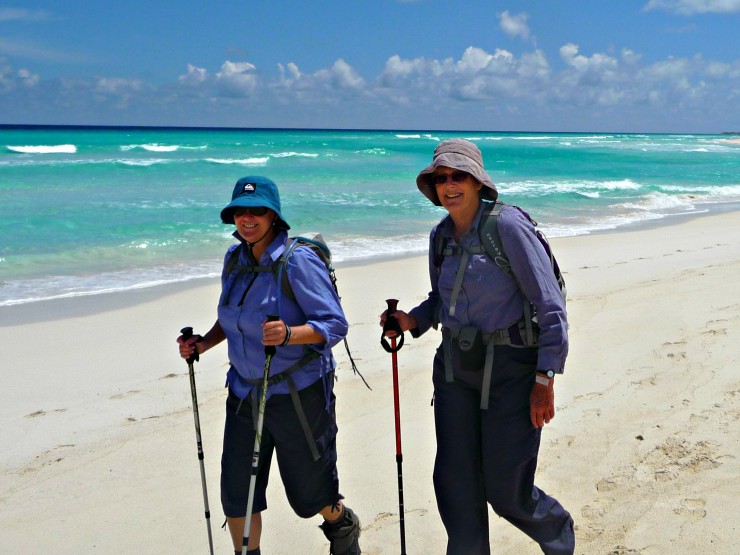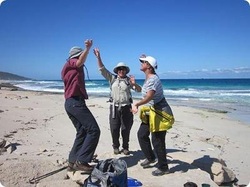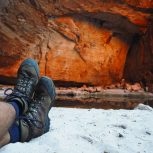The best way to dress for hiking

The best way to dress for hiking
Posted on
So, you are heading out to the hills an hour away from home in a climate controlled car. You are wearing jeans and a shirt and feeling quite comfortable as the suburbs disappear and the trees get thicker.
You step out of the car and are hit by a wall of cold. The jumper comes out because you don’t want to be cold for your 3 hour walk.
10 minutes into the walk, the jumper comes off.
30 minutes later you are wondering if anyone else is on this walk trail because you are seriously considering shedding the jeans!
Getting the right clothing for hiking is not a trivial or vain. It is important to get it right so that you will be comfortable and enjoy the experience… otherwise, what is the point!
The best way to dress for hiking – our tips from head to toe
Tip One: Peaked caps for rain, Broad brimmed hats for warm conditions – but….
I wear a hat in the middle of winter. Not for the sun and not for the warmth, but for rain. When the rain comes I put on my hood (either from my jacket or poncho) and without a peaked cap I can’t see a thing. The hat gives the hood some shape and allows me to retain a bit of peripheral vision.
If you are getting yourself a broad brimmed hat for sunny conditions (recommended), just remember to try it on when you wearing your back pack. I have made this mistake in the past and been stuck on a 7 day walk from Albany to Denmark with a hat that rubbed up against my back pack. Sounds trivial, but 6 hours into the second day, the pocket knife came out!
second day, the pocket knife came out!
Another option is a legionnaires hat with the flap on the back. Whilst not often found on the cat walks of Milan, the legionnaires hat is good option for protecting your neck from sun burn.
Tip Two: You are probably going to be hotter than you think – take thin layers.
Ever been skiing? Every time I have been skiing, despite the freezing temperatures, I reckon I could have cooked half a dozen crayfish in my ski suit I have been so hot. It is the same with hiking. As soon as you start walking, the jumpers will come off. Chances are, even if you are walking in the snow, you are going to be much hotter than you think, especially so if it is hilly alpine country.
We recommend taking thin layers and not to wear anything that is too hard to take off. Thermals that you wear under your shirt are only for REALLY cold temperatures, as once you start walking you will be boiling with no option but to strip in order to get the blasted thing off!
Thin layers goes for wet weather gear as well. If you are buying a rain jacket, go for something lightweight. If you have to, you can always wear a thin jumper underneath, but if you go for something too warm, your only option to cool down is to take the rain jacket off and get wet.
Tip Three: Wear lightweight pants that don’t require a belt.
Jeans are an absolute no no. They are hot and take forever to dry when wet. We recommend lightweight trousers. They are perfect in almost all conditions as they dry quickly, are not too hot and they protect your legs from scratches and even snake bites (if worn with long socks).
We get plenty of Kiwi’s on our walks and in wet conditions they often wear Skin leggings with a pair of shorts over the top. I am going to try this technique out this spring as it seems perfect for not only soggy conditions, but also for river crossings. I will be sure to report my findings.
As for the not belt thing, it may be comfortable when you try on your backpack at home, but chances are the belt and backpack will combine into a nice bruise after a few hours. Try to wear pants that don’t require a belt if you can. If you must wear a belt, then go for something that is reasonably soft.

Tip Four: Doing the rounds in gaiters and two pairs of socks.
Next time you are in a generic supermarket, head down the garden care isle and pick up a pair of ankle high cloth lawn mowing gaiters. These little guys are great for keeping sand and stones out of your boots as well as keeping your socks a little cleaner and drier. For $3 you can’t go wrong!
In my opinion, the big heavy canvas gaiters are only really good for muddy conditions. Lightweight pants are generally more than enough protection from spinafex or other scratchy vegetation and will even do you for snake bites if you combine them with long socks.
Two pair of thin socks is another great tip. This can reduce the chances of developing blisters significantly, as the socks wear against each other, rather than the shoe rubbing against you.
So there we have our tips for the best way to dress for hiking. If you have any more tips we would love to hear from you below.



